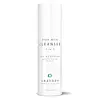What's inside
What's inside
 Key Ingredients
Key Ingredients

 Benefits
Benefits

 Concerns
Concerns

 Ingredients Side-by-side
Ingredients Side-by-side

Water
Skin ConditioningDicaprylyl Carbonate
EmollientGlycerin
HumectantPentylene Glycol
Skin ConditioningC14-22 Alcohols
Emulsion StabilisingBehenyl Alcohol
EmollientHydrogenated Vegetable Oil
EmollientSodium Stearoyl Glutamate
CleansingC12-20 Alkyl Glucoside
EmulsifyingCitric Acid
BufferingParfum
MaskingGlyceryl Caprylate
EmollientGlycine Soja Oil
EmollientSclerotium Gum
Emulsion StabilisingSodium Benzoate
MaskingTocopherol
AntioxidantXanthan Gum
EmulsifyingCamellia Sinensis Leaf Extract
AntimicrobialCoco-Caprylate/Caprate
EmollientCaprylic/Capric Triglyceride
MaskingGlyceryl Stearate
EmollientCoco-Caprylate
EmollientSodium Olivoyl Glutamate
CleansingCetearyl Alcohol
EmollientCetyl Alcohol
EmollientStearyl Alcohol
EmollientPrunus Armeniaca Kernel Oil
MaskingNiacinamide
SmoothingCoco-Betaine
CleansingGlycerin
HumectantPhenethyl Alcohol
MaskingPentylene Glycol
Skin ConditioningPropanediol
SolventLauryl Glucoside
CleansingPolyglyceryl-2 Dipolyhydroxystearate
Skin ConditioningAloe Barbadensis Leaf Juice
Skin ConditioningDicaprylyl Carbonate
EmollientTocopherol
AntioxidantXanthan Gum
EmulsifyingSodium Stearoyl Glutamate
CleansingCitrus Paradisi Peel Oil
MaskingCitrus Aurantium Dulcis Peel Oil
MaskingPelargonium Graveolens Flower Oil
MaskingCamellia Sinensis Leaf Extract, Coco-Caprylate/Caprate, Caprylic/Capric Triglyceride, Glyceryl Stearate, Coco-Caprylate, Sodium Olivoyl Glutamate, Cetearyl Alcohol, Cetyl Alcohol, Stearyl Alcohol, Prunus Armeniaca Kernel Oil, Niacinamide, Coco-Betaine, Glycerin, Phenethyl Alcohol, Pentylene Glycol, Propanediol, Lauryl Glucoside, Polyglyceryl-2 Dipolyhydroxystearate, Aloe Barbadensis Leaf Juice, Dicaprylyl Carbonate, Tocopherol, Xanthan Gum, Sodium Stearoyl Glutamate, Citrus Paradisi Peel Oil, Citrus Aurantium Dulcis Peel Oil, Pelargonium Graveolens Flower Oil
Ingredients Explained
These ingredients are found in both products.
Ingredients higher up in an ingredient list are typically present in a larger amount.
Dicaprylyl Carbonate comes from carbonic acid and caprylyl alcohol, a fatty alcohol. It is an emollient and gives skin a velvet feel. The sources of Dicaprylyl Carbonate may be synthetic or from animals.
As an emollient, Dicaprylyl Carbonate creates a film on the skin. This film traps moisture in, keeping your skin soft and hydrated.
Glycerin is already naturally found in your skin. It helps moisturize and protect your skin.
A study from 2016 found glycerin to be more effective as a humectant than AHAs and hyaluronic acid.
As a humectant, it helps the skin stay hydrated by pulling moisture to your skin. The low molecular weight of glycerin allows it to pull moisture into the deeper layers of your skin.
Hydrated skin improves your skin barrier; Your skin barrier helps protect against irritants and bacteria.
Glycerin has also been found to have antimicrobial and antiviral properties. Due to these properties, glycerin is often used in wound and burn treatments.
In cosmetics, glycerin is usually derived from plants such as soybean or palm. However, it can also be sourced from animals, such as tallow or animal fat.
This ingredient is organic, colorless, odorless, and non-toxic.
Glycerin is the name for this ingredient in American English. British English uses Glycerol/Glycerine.
Learn more about GlycerinPentylene glycol is typically used within a product to thicken it. It also adds a smooth, soft, and moisturizing feel to the product. It is naturally found in plants such as sugar beets.
The hydrophilic trait of Pentylene Glycol makes it a humectant. As a humectant, Pentylene Glycol helps draw moisture from the air to your skin. This can help keep your skin hydrated.
This property also makes Pentylene Glycol a great texture enhancer. It can also help thicken or stabilize a product.
Pentylene Glycol also acts as a mild preservative and helps to keep a product microbe-free.
Some people may experience mild eye and skin irritation from Pentylene Glycol. We always recommend speaking with a professional about using this ingredient in your routine.
Pentylene Glycol has a low molecular weight and is part of the 1,2-glycol family.
Learn more about Pentylene GlycolSodium Stearoyl Glutamate is an emulsifier and helps condition the skin. It is amino acid-based.
In higher amounts, it may act as a cleansing agent.
Tocopherol (also known as Vitamin E) is a common antioxidant used to help protect the skin from free-radicals and strengthen the skin barrier. It's also fat soluble - this means our skin is great at absorbing it.
Vitamin E also helps keep your natural skin lipids healthy. Your lipid skin barrier naturally consists of lipids, ceramides, and fatty acids. Vitamin E offers extra protection for your skin’s lipid barrier, keeping your skin healthy and nourished.
Another benefit is a bit of UV protection. Vitamin E helps reduce the damage caused by UVB rays. (It should not replace your sunscreen). Combining it with Vitamin C can decrease sunburned cells and hyperpigmentation after UV exposure.
You might have noticed Vitamin E + C often paired together. This is because it is great at stabilizing Vitamin C. Using the two together helps increase the effectiveness of both ingredients.
There are often claims that Vitamin E can reduce/prevent scarring, but these claims haven't been confirmed by scientific research.
Learn more about TocopherolXanthan gum is used as a stabilizer and thickener within cosmetic products. It helps give products a sticky, thick feeling - preventing them from being too runny.
On the technical side of things, xanthan gum is a polysaccharide - a combination consisting of multiple sugar molecules bonded together.
Xanthan gum is a pretty common and great ingredient. It is a natural, non-toxic, non-irritating ingredient that is also commonly used in food products.
Learn more about Xanthan Gum